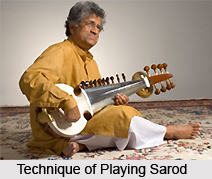 Sarod is one of the leading concert instruments of North Indian Classical Music. This string instrument is most likely non-Indian in origin. The Sarod has four melody strings tuned to Sa, Pa, Sa, Ma and it is played with a triangular plectrum. The melodic techniques of Sarod can be divided into three different types that are discussed below:
Sarod is one of the leading concert instruments of North Indian Classical Music. This string instrument is most likely non-Indian in origin. The Sarod has four melody strings tuned to Sa, Pa, Sa, Ma and it is played with a triangular plectrum. The melodic techniques of Sarod can be divided into three different types that are discussed below:
First Technique of Playing Sarod
In the first type of technique of playing Sarod the fingers are moved along the finger board without lifting the fingers from the melodic string. The design and the ergonomics of the handling of the instrument make this the fundamental technique of executing any melodic phrase in the slow-to-medium tempi. Thus, the primary melodic character of the instrument is conjunct rather than disjunct. It is the limited sustain of the instrument and the necessity for higher stroke frequency. It tilts the bias of the aural experience in favour of the rhythmic element and melodic discontinuity.
Minda: The minda is a unidirectional glissando of short-melodic span executed under a single stroke.
Murki: The murki is phrase executed by a bi-directional glissando under the power of a single stroke. It involves a wrap-around movement around one svara with jerky motion mostly at the point of direction-reversal.
Gamaka: A gamaka is a magnified vibrato formed by repeatedly hitting a target svara from an adjacent svara, under multiple stroke activation.
Ghasita: A ghasita is a minda of broad melodic span, generally a full octave or more. The technique is borrowed from the suta technique of the Rudra Veena.
Second Technique of Playing Sarod
The second type of technique of playing Sarod implements the alternative use of two fingers on the same melodic string. Being a fretless instrument, finger-work belongs to the special effects department of the saroda idiom.
Sparsa: The sparsa engages the lifting of one finger from the string instantly after the stroke, and allowing the other finger to execute the adjacent svara. The two near-simultaneous svaras can be triggered either under a single stroke or even two or more strokes.
Krintana: Krintana is a specialty of the sitar and engages the execution of a phrase of four or more svaras under the power of a single stroke. The first svara of the phrase receives stroke power and the subsequent svaras are powered by the action of the middle finger being lifted from one svara, and the index finger attacking an adjacent svara.
Third Technique of Playing Sarod
The third type of technique of playing Sarod multiple-string execution inevitably requires the alternative use of two fingers. This facet of the Sarod technique, possessing elements of the polychord, dominates the aural experience in the medium-to-faster tempi, especially in broad-span melodic phrasing. This facet is emphasized by regarding the multiplicity of melodic strings as a distinctive musical element rather than unavoidable. Saroda players revel in opportunities for a harp-like activation of the melodic strings, and compose symmetric, geometric, and kaleidoscopic patterns to maximize such exposure.




















